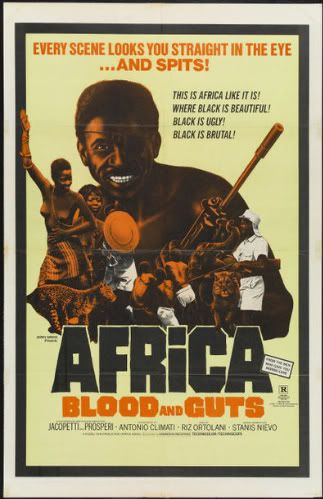
Tonight we'll focus on two Italian filmmakers who are no strangers to controversy.Having shocked the entire world in creating what would come to be known as the "mondo" film in 1962 with Mondo Cane, they would outdo themselves a thousand-fold with the release of tonight's entry just four years later, a searing portrait of a changing continent that the film's detractors(which include Roger Ebert) have accused of being bathed in pro-white European colonial racism(Europeans filmed in soft focus as their properties are seized, black Africans shot with a fish-eye lens from unflattering angles) and chock full of staged sequences, to which Jacopetti responded with an adamant denial, claiming that the only footage the two men ever staged appeared in the earlier Mondo Cane 2, and that everything one sees within Addio is completely real.Jacopetti even found himself being tried for murder in Italian court over the film, amidst accusations that one of the on-screen executions in the movie was staged for the cameras.He was eventually acquitted.West German protesters at screenings of the film in Berlin are looked upon as the first anti-racist movement that Germany had ever experienced, and the film was banned outright as racist in Italy.The U.S. cut, Africa:Blood and Guts, released four years later in 1970, is even more sensaltionalist.
Inevitably, I'm forced to interject my own personal feelings on the controversial film here.Addio is an important work, both shocking and thought-provoking, in that it reveals not a biased slant towards white or black(it really doesn't), but the depraved depths we as a species can sink to, if left to our own devices.The unflinching lens of two documentary filmmakers shows us our own preordained nature which harbors both redeeming good and deplorable evil.It's who we all are, it's what we all do to differing extents.Whether or not you can handle a film like this that evokes great emotion in every single frame depends entirely on how big the horse blinders you've chosen to experience life through are.If this all seems a bit too unsettling for you, I suggest you screen the film anyway, as it may just be the wake up call you need.

A cruel bonfire burns out of control.
At the outset, we see the dark continent as it says farewell to its old colonial ways, and welcomes a new era with Great Britain providing much pomp and circumstance as the guard changes.Then there's a fox hunt, only the fox in this case is dead, lending its scent to the hounds, and handled by a running African native.Then we see the trial of some Africans who've snuck onto a British-owned farm and murdered everyone in their sleep, slashing the tendons in the legs of the livestock as some added cruelty.We then turn to the auctioning of white European property and belongings to Africans who remain.A lush estate once owned by whites gets impromptu landscaping via explosions and bulldozers and is now occupied by a hundred Africans who bust up the furniture for a bonfire and use the bathtub as a makeshift playpen for multiple infants.Then we watch hundreds of black Africans trying to tame a group of wild horses, that, according to narration, is "physically racist" and fearful of being handled by the blacks.Finally, we bear witness to the mass southerly migration of displaced Boer farmers, before dropping in on a big game hunt, edited for time by a helicopter driving a bull elephant directly to a hunter so that he can shoot it dead from point blank range, as compared to a massive throng of natives group-spearing a wide variety of animal species, not excluding a bull elephant and a hippopotamus that they repeatedly spear like a colossal pin cushion.Then we witness European volunteers rescuing and rehabilitating a wounded,sick elephant, with one poor bastard losing his arm past the elbow in the massive beast's turd cutter.All together now,bleeech.Next we focus on the poacher element that has been exploiting the chaotic political climate to rape the African plains of countless animal skins and tons worth of ivory tusks, before watching a baby zebra rescued from its mother's lifeless,poached corpse by airlift as the sun sets.
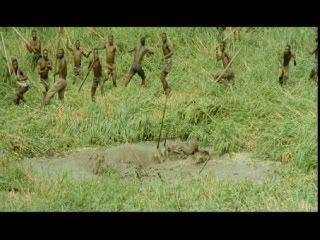
The only spears not sticking out of this poor hippo is probably Britney.
The Italians document a massacre of Arabs by African insurgents in Zanzibar by plane, complete with burned out villages, mass graves, and beaches scattered with Muslim cadavers.The camera then follows the quelling of an Angolan rebel uprising by mercenaries, complete with firefight and obligatory smoked out,flaming corpses; before we turn to the Bantu massacre of Watusi in Rwanda as evidenced by piles of amputated hands and post-murder Bantu perps mugging for the camera.Before we're too sickened by human v. human violence, the lens again focuses on animal violence, as several antelope, elephants, and hippos are sent to their maker by point blank, high caliber death, then hacked into sections for the cameras(a pregnant hippo corpse is robbed of its unborn fetus and a jeep drags a grue-stained severed elephant head across the terrain in low points of the segment,where the Italians remark that the most ferocious animal in Africa has to be man himself.).A vast wasteland of dried animal bones is tragically panned across.We then set our sights on the miracle of South Africa, as bikini-clad Euro girls run, swing, and do trampoline flips in slow motion juxtaposed against the backdrop of Cape Town(my favorite segment,I ain't gonna lie to ya), then some Africans in traditional Zulu garb break out some instruments and play some rock n' roll, before we see modernized tribeswomen adopting the clothing and mannerisms of European women, and the League of Decency handing out bvds to Zulus(!).I say, put that Alabama blacksnake away, M'butu.Pantsify yourself, old chap.Then we follow a libidinous male lion unable to get his swerve on due to carloads of voyeuristic tourists.The aftermath of a muslim massacre in Tanganyika is captured on film, and then unrest in Uhuru Square where the filmmakers are nearly executed before someone notices that "they aren't white, they're Italians".A massacre in Stanleyville by Simba rebels is also documented, and the subsequent counterattack by mercenaries, black and white bodies alike feeding the scavengers.Finally, we examine the gold and diamond industry before focusing on a small group of penguins on the crashing surf at sunset.Wow.
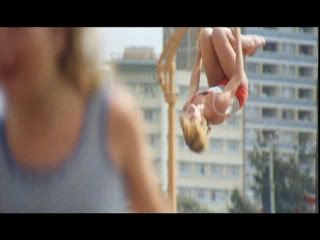
White South African girls enjoying their favorite pastime: slo-mo trampoline flips.
Let the squeamish be forewarned, there's enough wholesale animal murder and mutilation(set to a mostly upbeat score by maestro Riz Ortolani)captured here for a hundred Umberto Lenzi movies, and nearly as much human slaughter to match it.The U.S. print(Blood and Guts)removes most of the non-exploitative material, leaving just 90 expurgated minutes worth of human cruelty, as opposed to the nearly two and a half hour running time of the director's cut, as included in Blue Underground's excellent Mondo Cane Collection, released a few years back; a necessary addition to any worthwhile genre collection, indeed.An amazing movie, by any standards, and completely successful in generating a response from its audience with its cruel and powerful imagery that few could dismiss easily.You may never see another movie like it, but you owe it to yourself to give it a shot, at least once.A closed minded leftist idiot like Roger Ebert may have given you zero stars back in 1967, but Addio, you're four wops from first frame to last, to me, baby.Highest recommendation.

"Don't back up over that unusual looking rumble strip, boys, you'll blow the tires..."





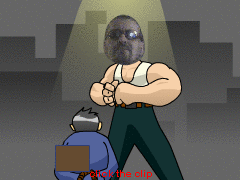

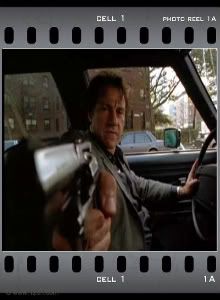

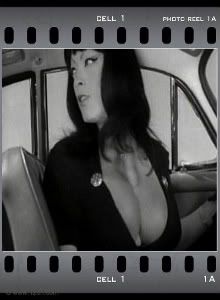
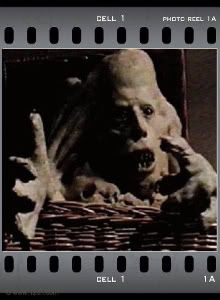





























2 comments:
d'accordo!
Grazie, B!
-Wop
Post a Comment